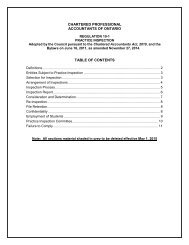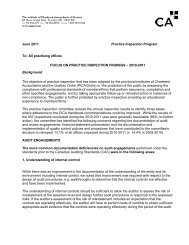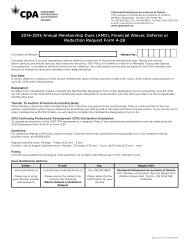CM Autumn Template - Institute of Chartered Accountants of Ontario
CM Autumn Template - Institute of Chartered Accountants of Ontario
CM Autumn Template - Institute of Chartered Accountants of Ontario
You also want an ePaper? Increase the reach of your titles
YUMPU automatically turns print PDFs into web optimized ePapers that Google loves.
places where they were now working. Many students had<br />
gone to work for much bigger firms and felt they were not<br />
getting the practical work experience that we <strong>of</strong>fered, and <strong>of</strong><br />
course, many were putting in extremely long overtime hours.<br />
The students our <strong>of</strong>fice trained received a full<br />
understanding <strong>of</strong> how an accounting firm operates and the<br />
expectations <strong>of</strong> the clients. They learned that customer<br />
service was extremely important and made sure that we<br />
met the clients’ expectations. We always thought that<br />
students who work for smaller firms can receive excellent<br />
accounting experience in many relevant areas. The<br />
experience would not be the same as in a big firm,<br />
especially in the audit areas. However, in many other ways,<br />
the students would be receiving practical experience that<br />
they could use in a variety <strong>of</strong> positions if they wished to go<br />
into industry or the government, or have the knowledge to<br />
perhaps consider opening their own accounting firm.<br />
I would recommend any firm that is willing to spend time<br />
and effort to train students, to consider this possibility.<br />
Phan: Are there any other comments that you would like to<br />
share about your experience with this program?<br />
Gary: I have advocated and sent letters for the past 10<br />
years on how I thought the training process needed to be<br />
changed. It has happened and I am very pleased. It is a<br />
win-win for students and employers alike.<br />
John Morgan, CA, CA•CIRP, CFE,<br />
CBM – Insolvency & Bankruptcy and<br />
CA Training Office<br />
Morgan & Partners Inc.<br />
provides insolvency and<br />
trustee bankruptcy services<br />
and is owned by John<br />
Morgan, CA, CA-CIRP, CFE,<br />
CBM. He also owns JJM &<br />
Associates Inc., which<br />
provides litigation support and<br />
forensic accounting services.<br />
While the CA student will<br />
primarily work at his two firms,<br />
the three-year training<br />
program also includes<br />
secondments to two local CA<br />
firms where the student will be<br />
exposed to audit, review and tax engagements.<br />
Richard: Why did you become a CA Training Office in a<br />
non-traditional path?<br />
John: Most small-to-medium sized companies need a parttime<br />
CFO, and look to their advisors to provide such a<br />
service. In order to add value, consultants need not only<br />
understand the business model but also when these<br />
businesses are getting into trouble. Exposing a CA student<br />
to an insolvency practice is, in my opinion, a fantastic<br />
training opportunity where the CA student can develop the<br />
competencies required <strong>of</strong> the pr<strong>of</strong>ession, gain hands-on<br />
experience with many aspects <strong>of</strong> running a business –<br />
including what not to do – and develop a specialty in fraud<br />
and forensics.<br />
Richard: In developing your CA Training Program, you<br />
decided to partner with two local CA firms, neither <strong>of</strong> which<br />
were previously approved to train CA students. Why did<br />
you include these secondments and how did you develop<br />
this partnership?<br />
John: Seconding the CA student to a CA firm environment<br />
provides a more well-rounded experience, which includes<br />
understanding the integration <strong>of</strong> tax consequences from<br />
certain transactions. In addition, it enables the CA student<br />
to earn chargeable hours that will assist in subsequently<br />
obtaining a licence to practise public accounting, should<br />
that be a career path <strong>of</strong> interest down the road. The<br />
training partnership was merely an extension <strong>of</strong> a preexisting<br />
alliance between the three firms.<br />
Richard: How does this program fit with your business<br />
growth or succession-planning strategies?<br />
John: Corporate reorganizations and forensics are big and<br />
growing practice areas that require individuals being<br />
trained to think in a different way from the traditional<br />
assurance-based model. My business has grown from<br />
referrals and established networks, so grooming the talent<br />
in-house provides me with the confidence <strong>of</strong> handing over<br />
client files earlier than would be the case if I had to train a<br />
qualified CA on the specialized knowledge that can only<br />
be achieved by working in the business. In addition, there<br />
are very few licensed trustees in <strong>Ontario</strong>, so providing an<br />
opportunity for a CA to subsequently become a licensed<br />
trustee fosters a potential succession plan that would<br />
otherwise be quite limited in scope.<br />
Richard: As a non-traditional CATO, your CA students will<br />
not necessarily have the chargeable hours required to<br />
obtain a licence to practise public accounting. How does<br />
that impact your staffing needs and/or succession plan?<br />
John: A licence to practise public accounting is not<br />
required for my business and the two sole proprietors that<br />
the CA student is seconded to weren’t necessarily viewing<br />
this arrangement in terms <strong>of</strong> succession planning. Rather,<br />
the sole proprietors benefitted from an extra resource<br />
without the obligation <strong>of</strong> a full-time headcount. Of course, a<br />
viable exit strategy for any firm is to sell the business, and<br />
there is the potential for the student to obtain the required<br />
chargeable hours for licensure in order to take advantage<br />
<strong>of</strong> those opportunities.<br />
Richard: You have been involved with training students<br />
pursuing various designations. Has your ability to recruit<br />
CA students had an impact on the quality <strong>of</strong> employee(s)<br />
you have attracted?<br />
CheckMark • <strong>Autumn</strong> 2009<br />
(Please see page 26)<br />
25












